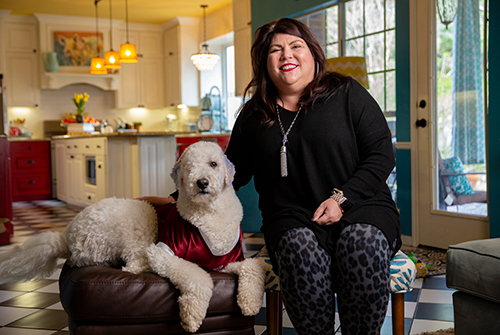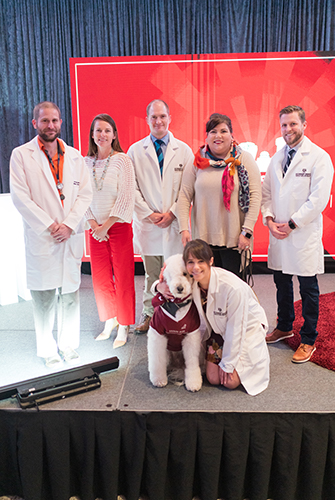 Andrea Streicher and her dog, Werner, are grateful for the care they received at Texas A&M’s Veterinary Medical Teaching Hospital (VMTH). Werner had a bleak prognosis until VMTH staff members came up with an innovative solution for his treatment.
Andrea Streicher and her dog, Werner, are grateful for the care they received at Texas A&M’s Veterinary Medical Teaching Hospital (VMTH). Werner had a bleak prognosis until VMTH staff members came up with an innovative solution for his treatment.
By Corley-Ann Parker '20
When Andrea Streicher saw the photos of the curly-haired, golden puppies a friend had sent her, it was love at first sight. Her day had started off with a series of unfortunate events—including a flat tire—but there in front of her was the antidote to all her doldrums.
Werner, a “double doodle” with Goldendoodle and Labradoodle parents, immediately joined the Streicher household and proved himself to be a happy, social and active dog.
He could often be found running around a dog park in their hometown of Austin, donning silly costumes or funky bandannas that matched his personality. Because of Werner’s excellent demeanor with children, Streicher aspired to train him as a therapy dog.
"We dyed his ears blue for his first birthday, and I noticed when his ears were blue that little kids were so drawn to him,” Streicher said. “We now keep his ears blue, so that when he goes to schools to help with readings and stuff, the kids will still be drawn to him.”
A Disheartening Diagnosis
At just around two years of age, Werner started becoming lethargic and depressed and began having seizures. Concerned, Streicher took him in to her local veterinarian, where they found that Werner had a huge, rapidly growing skull tumor.
“When we first started having problems, the tumor was probably the size of my thumbnail. It was like a grape,” Streicher recalled. “Three weeks later, it was almost the size of an egg.”
Streicher met with several veterinarians who told her that they had never seen such an aggressive tumor in such a young dog and that they feared his tumor would be inoperable.
Of course, the diagnosis came as a shock for Streicher and her family. “We waited 24 hours until I could talk with the neurologist, and she basically said that it was huge,” she said. “It was super invasive. She said our main objective should be to keep Werner comfortable.”
Despite the grim prognosis, Streicher wasn’t about to give up on Werner. She decided to take him to Texas A&M’s Veterinary Medical Teaching Hospital (VMTH), thinking that if Werner's prognosis was so bleak, he could at least contribute to the greater good and help veterinary students learn from his case.
“I thought he wasn’t going to survive, and if I lost him, I wanted his body to go to the veterinary students at Texas A&M so that they could study him and learn from his disease,” Streicher recalled.
There, the VMTH team swiftly admitted Werner for a CT scan and confirmed the tumor took up a significant portion of his skull and was compressing his brain.
After the veterinary team spent some time analyzing Werner’s case, they gave Streicher some news she didn’t anticipate: They would be able to operate and attempt to remove the tumor. Werner would likely lose an eye and there was no guarantee of a successful surgery, but the doctors were confident they had a solution to heal Werner.
The next step before surgery was to perform a bone biopsy to confirm the specific type of cancer Werner was suspected to have. After about two weeks of waiting, the biopsy results returned and confirmed that Werner's tumor was a multilobular tumor of bone.
Multilobular tumors are rare, and there are no known predispositions to this particular type of cancer. These tumors typically occur on flat bones, and in canines, the skull is the most common area they arise. Surgical removal of these tumors is tricky, and it is often impossible to remove the tumors from the skull with clean margins.
Collaborating to Cure
On Oct. 10, 2018, when Werner checked in for his surgery, the VMTH neurology and oncology teams had come up with an innovative solution.
Because of the amount of skull Werner would lose in the operation, his clinicians would need to find a way to rebuild his skull from scratch. Dr. Michael Deveau, a clinical assistant professor in the College of Veterinary Medicine & Biomedical Sciences and holder of the Katherine and Rebecca Rochelle Chair in Oncology, reviewed CT scans of healthy dogs to generate a new skull piece that would replace the excised portion of bone. He collaborated with Dr. Elizabeth Scallan in the Clinical Skills Laboratory to make a 3D print of the skull replacement pieces and to engineer a mold that could be used in the operating room.
 Werner's team of doctors from the Veterinary Medical Teaching Hospital surgically removed his tumor and replaced a section of his skull with man-made bone.
Werner's team of doctors from the Veterinary Medical Teaching Hospital surgically removed his tumor and replaced a section of his skull with man-made bone.
During surgery, Dr. Joseph Mankin in the neurology service and Dr. Maya Krasnow, a second-year resident in neurology, filled the mold with a material called poly methyl methacrylate (PMMA), a type of shatter-resistant plastic. The PMMA hardened in minutes, and readily created Werner’s new skull. Beside them, Dr. Brandon Wustefeld-Janssens, one of the VMTH’s veterinary oncologists, removed Werner’s right eye.
After his eight-hour surgery, Werner faced a long recovery. “The first night was rough,” Streicher remembered. “I’m not going to lie—I wondered if I did the right thing, if I kept him here for me, or if I kept him here because it was the right thing to do.”
But after several nights of sleeping by Werner’s side at home, things started to look up. Werner’s original, playful attitude started to shine through again, so much so that he had to return to the VMTH mid-recovery to have more stitches placed around his incision areas for security.
“I literally had to hide all the toys, because we wouldn’t throw them to him, so he would throw the toy himself,” Streicher said with a laugh.
Werner’s team of clinicians is equally impressed with his recovery and credit collaboration with the success of his operation. “When a client comes to an academic institution like the Texas A&M Veterinary Medical Teaching Hospital, they’re typically coming because we offer strengths that other practices may not be able to provide,” said Dr. Deveau. “We should be able to do things that nobody else can do, and if there isn’t an easily apparent way to do something, then we can pool our resources, put our heads together and have an outcome that may benefit patients like Werner.”
Streicher hopes to have Werner certified as a therapy dog soon to help comfort children undergoing treatment for cancer. “He is just amazing,” Streicher said. “The fact that he’s still here is just a miracle. He is Werner the Wonder Dog.”
The Streicher family is extremely grateful for the efforts made by the team at Texas A&M to save Werner’s life. Specifically, Streicher said she credits Texas A&M with “taking the chance.” For that, she says she will always recommend Texas A&M for quality veterinary care.
“If you need any care that goes above and beyond, just go to Texas A&M. Just do it. You won’t be sorry,” she said.
At the end of February, Streicher brought Werner back to College Station, but as a guest of honor instead of a patient. Werner’s story was showcased as one of four exhibits at the Texas A&M Foundation’s Exploration Day, which provided immersive experiences for top university donors from disciplines across campus. Werner appeared on stage as the grand finale of the college’s exhibit and received a standing ovation.
As a tribute to the team that saved his life, Werner wore a 12th Man jersey, while his famous blue ears were dyed maroon to honor the Aggies who never gave up on saving his life.
To support further innovations in veterinary medicine, please contact Chastity Carrigan, assistant vice president for development for the College of Veterinary Medicine & Biomedical Sciences, at ccarrigan@txamfoundation.com or (979) 845-9043.